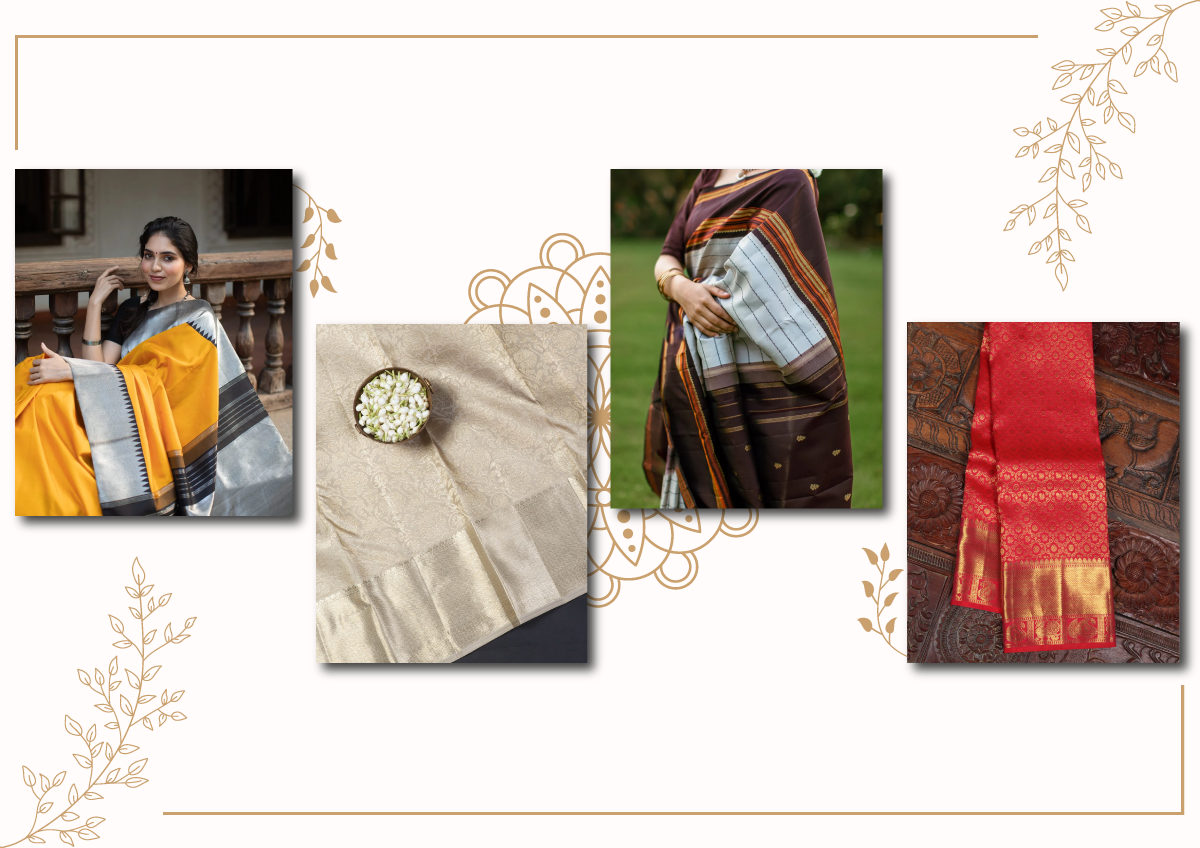Types of Kanchipuram Silk Sarees for Wedding & Pure Kanjivaram Pattu Motifs
Kanjivaram silk or Kanchipuram pattu sarees are centuries-old traditional silk sarees that originate from the South Indian state of Tamil Nadu, known for their luxurious texture and intricate designs. The rich history of Kanjivaram sarees can be traced back to the times of the Chola dynasty, over a thousand years ago. They were worn by royalty as a symbol of wealth and status.
Kanjivaram pattu sarees are woven from pure mulberry silk and are known for their strong, durable, and glossy texture. The weaving process of a Kanjivaram silk saree involves multiple artisans, who work together to produce a single piece that can take anywhere from 15 days to several months to complete. The intricate motifs and designs on Kanchipuram sarees are created using the tie and dye method where each individual thread is dyed to a specific colour before it is woven into the fabric.
If you want to explore more heritage weaves, visit the full collection of Kanjivaram Silk Sarees at Tulsi Silks: https://tulsisilks.co.in/category/kanjivaram-silk-sarees
The designs on Kanjivaram silk sarees are inspired by the rich heritage and cultural traditions of Tamil Nadu, with motifs that depict Hindu gods, nature, and daily life. Kanjivaram sarees are also known for their rich borders and pallus, which add to their grandeur.
To explore more heritage silk drapes, visit:
Silk Sarees: https://tulsisilks.co.in/category/silk-sarees
Types of Kanjivaram silk sarees
Kanjivaram silk sarees have been a part of the Indian tradition and are loved by women across India. Kanchipuram sarees managed to keep up their legacy even after modernisation and are still being woven with supreme artistry, they come in a variety of designs and patterns that caters to the demands of today’s generation. There is a unique fandom for the original pure Kanjivaram or Kanchipuram pattu sarees. Let’s see the varieties of Kanjivaram sarees that you can add to your authentic saree collection.
1. Traditional Kanjivaram Sarees
The traditional Kanjivaram sarees are also known as the handwoven Kanjivaram sarees which are usually woven in the traditional technique of weaving a Kanjivaram saree and are heavier than the other types of Kanchipuram sarees. These sarees embody beautiful motifs like coin and chakra motifs with distinct borders with intricate designs. Explore the full range here: https://tulsisilks.co.in/category/traditional-kanjivaram-silk-sarees
2. Korvai Kanjivaram Sarees
The korvai Kanjivaram saree is a Kanchipuram weave native to South India that involves hand-weaving methods. These sarees are made from pure natural silk and have rustic look because of their traditional weaving method.
3. Thread Brocade Kanjivaram Sarees
The thread brocade Kanjivaram sarees are weaved using one of the oldest traditional weaving methods that involve the artistic intertwining of the pure gold thread with the silk thread. Making brocade Kanjivaram sarees is a laborious process of carefully weaving together the golden and silk thread to create beautiful hues.
4. Classic Kanjivaram/Kanchipuram Pattu Sarees
The classic Kanjivaram pattu sarees are enough to make any occasion special. These sarees are traditionally weaved with wide and contrasting borders that make all eyes turn. These sarees feature intricate motifs that are inspired by Hindu mythology and nature. The borders are attached separately to the body of the Kanjivaram saree and are so strong that even if the saree tears the borders cannot be detached from the sarees. Explore the Classic collection: https://tulsisilks.co.in/category/kanjivaram-classic-silk-sarees
5. Pattupettu Kanjivaram Sarees
Pattupettu Kanjivaram sarees are known for their intricate designs and elegant patterns woven using pure mulberry silk. The term "pattupettu" refers to the "buttis" or small round motifs woven into the saree's fabric. These Kanjivaram sarees are characterised by the small round buttis that are arranged in a specific pattern, creating an overall look that is both delicate and eye-catching.
6. Checked Kanjivaram Sarees
The checked Kanjivaram sarees are a staple design in the Kanjivaram family. These sarees have a colourful vibe and are always in style. Mostly worn for festivals checked kanjivaram sarees come in different varieties and sizes of checks. Checked Kanjivaram sarees come in double contrasting colours or multi colours that are loved by many.
Explore more checked patterns here: https://tulsisilks.co.in/category/checked-kanjivaram-silk-sarees
If you love contemporary prints too, explore
Printed Kanjivaram Silk Sarees: https://tulsisilks.co.in/category/printed-kanjivaram-silk-sarees
7. Zari Brocade Kanjivaram Sarees
The zari brocade Kanjivaram sarees are a timeless beauty and have a unique charm that makes them one of the most preferred Kanjivaram sarees. They are an integral part of the wedding trousseau because of the elegance and the exquisitely detailed zari work which radiates a glossy texture that enhances the beauty of the wearer.
Explore our bridal Kanjivaram pattu sarees here: https://tulsisilks.co.in/category/bridal-kanjivaram-silk-sarees
For more zari-rich sarees: https://tulsisilks.co.in/category/kanjivaram-pattu-silk-sarees
For more embroidery-rich sarees, see
Embroidery Kanjivaram Sarees: https://tulsisilks.co.in/category/embroidery-kanjivaram-silk-sarees
8. Without Border Kanjivaram Sarees
Borderless Kanjivaram sarees are the result of combining tradition with fashion. These sarees became a sensation and were loved by women who aren’t a fan of big borders. Kanjivaram sarees without border is a fashionable break from the conventional Kanjivarams that are known for contrast and heavy borders.
You can choose any type of Kanjivaram silk saree but draping the Kanjivaram silk saree properly is what makes all the difference.
Other Kanjivaram Varieties You May Love
Pure silk Kanjivarams:
https://tulsisilks.co.in/category/kanjivaram-pure-silk-sarees
Plain Kanjivarams for minimal elegance:
https://tulsisilks.co.in/category/plain-kanjivaram-silk-sarees
Tissue Kanjivarams for a subtle shimmer:
https://tulsisilks.co.in/category/kanjivaram-tissue-silk-sarees
Embroidery Kanjivarams:
https://tulsisilks.co.in/category/embroidery-kanjivaram-silk-sarees
Daily-wear lightweight Kanjivarams:
https://tulsisilks.co.in/category/daily-wear-kanjivaram-silk-sarees
Black Kanjivaram sarees for bold wedding looks:
https://tulsisilks.co.in/category/black-sarees
Explore all silk drapes in one place:
https://tulsisilks.co.in/category/view-all-six-yards
Shop the entire store:
https://tulsisilks.co.in/?srsltid=AfmBOopZEUUJMvOD14Kd3a-gp547arZhSNJYgkyfNTkHxFeIGqN9037J
Kanjivaram/Kanchipuram silk sarees designs, motifs and patterns
Motifs make an integral part of silk sarees and make the Kanchipuram pattu saree artistic and they hold a symbolic meaning. Motifs on Kanjivaram silk sarees are something that makes the sarees a unique work of art. Over the years there have been different varieties of motifs and patterns
1. Mayil motif - Peacock
The peacock is considered to be a symbol of grace and beauty and is one of the most popular motifs found on Kanjivaram silk sarees. Peacock motifs on Kanjivaram sarees feature intricate depictions of peacocks, either alone or in pairs, surrounded by foliage and flowers.
2. Maanga motif
The manga motif or paisley motif is another classic design that is often used on Kanjivaram silk sarees. This design features a teardrop-shaped pattern that is said to symbolize life, fertility, and good luck.
3. Yaali motif
Yaali is a mythical creature which is an amalgamation of different animals including a lion, elephant and horse. It holds a very high value in Hindu mythology and is also known as the divine defender. Yaali is a significant part of traditional Kanjivaram sarees. This motif is widely found in temples across South India.
4. Yanai - Elephant
The Yanai or the elephant motif is considered an auspicious motif in the traditional Kanjivaram sarees. The Yanai motif symbolises wealth, courage and wisdom. Usually embellished on the borders of a Kanjivaram saree, the Yanai motif is one of the most loved motif designs.
5. Kuthirai - Horse
The Kuthirai or the horse motif is a symbolic representation of freedom and power and is predominantly found in temples. The winged horse is another type of the Kuthirai motif which is a replica of the terracotta horse of the Hindu God Ayyanar which inspired the Kanchi weavers.
6. Rudraksha
The Rudraksha motif which is connected to Lord Shiva is believed to end miseries and heal illnesses. It is woven along the borders of the kanjivaram pattu sarees which makes them even more captivating and ethereal.
7. Iruthalai Pakshi - Two-headed eagle
The Iruthalai Pakshi motif as the name suggests refers to a double-headed eagle which in Hindu mythology is used as a sign of victory. It is referred to as Ganda-bherunda in mythology and the Kanjivaram saree motifs, it adds grandeur to Kanjivaram sarees.
8. Poo (Floral) Chakram
The Poo Chakram motif is one of the ancient and well-known motifs that is largely appreciated by everyone. This Kanjivaram motif involves intricate detailing that creates an alluring design when woven on the borders and pallu.
9. Mayilkan - Peacock’s eye
The Mayilkan motif inspired by the Peacock’s eye is another intricately woven motif on Kanjivaram sarees. This diamond-shaped motif is tightly woven on the Kanjivaram pattu sarees and is heavy with a lot of detailing. Buy your favourite type of Kanjivaram or Kanchipuram pattu saree from Tulsi Silks and experience the feeling of draping the eternal beauty. Tulsi Silks is one of the top places to buy silk sarees in Chennai.
Explore all our exclusive collections here:
Kanjivaram Silk Sarees: https://tulsisilks.co.in/category/kanjivaram-silk-sarees
Buy your favourite type of Kanjivaram or Kanchipuram pattu saree from Tulsi Silks and experience the feeling of draping the eternal beauty. Tulsi Silks is one of the top places to buy silk sarees in Chennai.
While you are here, check out our other blogs, know everything about silk sarees, and get tips to maintain your silk sarees.




